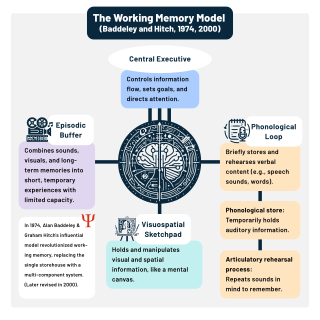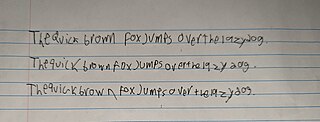
Dyslexia, previously known as word blindness, is a learning disability that affects either reading or writing. Different people are affected to different degrees. Problems may include difficulties in spelling words, reading quickly, writing words, "sounding out" words in the head, pronouncing words when reading aloud and understanding what one reads. Often these difficulties are first noticed at school. The difficulties are involuntary, and people with this disorder have a normal desire to learn. People with dyslexia have higher rates of attention deficit hyperactivity disorder (ADHD), developmental language disorders, and difficulties with numbers.

In linguistics, a grapheme is the smallest functional unit of a writing system. The word grapheme is derived from Ancient Greek γράφω (gráphō) 'write' and the suffix -eme by analogy with phoneme and other names of emic units. The study of graphemes is called graphemics. The concept of graphemes is abstract and similar to the notion in computing of a character. By comparison, a specific shape that represents any particular grapheme in a given typeface is called a glyph.
An orthography is a set of conventions for writing a language, including norms of spelling, punctuation, word boundaries, capitalization, hyphenation, and emphasis.
A phoneme is any set of similar speech sounds that is perceptually regarded by the speakers of a language as a single basic sound—a smallest possible phonetic unit—that helps distinguish one word from another. All languages contains phonemes, and all spoken languages include both consonant and vowel phonemes. Phonemes are primarily studied under the branch of linguistics known as phonology.
Agraphia is an acquired neurological disorder causing a loss in the ability to communicate through writing, either due to some form of motor dysfunction or an inability to spell. The loss of writing ability may present with other language or neurological disorders; disorders appearing commonly with agraphia are alexia, aphasia, dysarthria, agnosia, acalculia and apraxia. The study of individuals with agraphia may provide more information about the pathways involved in writing, both language related and motoric. Agraphia cannot be directly treated, but individuals can learn techniques to help regain and rehabilitate some of their previous writing abilities. These techniques differ depending on the type of agraphia.
A phonemic orthography is an orthography in which the graphemes correspond consistently to the language's phonemes, or more generally to the language's diaphonemes. Natural languages rarely have perfectly phonemic orthographies; a high degree of grapheme–phoneme correspondence can be expected in orthographies based on alphabetic writing systems, but they differ in how complete this correspondence is. English orthography, for example, is alphabetic but highly nonphonemic.

The Tiberian vocalization, Tiberian pointing, or Tiberian niqqud is a system of diacritics (niqqud) devised by the Masoretes of Tiberias to add to the consonantal text of the Hebrew Bible to produce the Masoretic Text. The system soon became used to vocalize other Hebrew texts as well.

Baddeley's model of working memory is a model of human memory proposed by Alan Baddeley and Graham Hitch in 1974, in an attempt to present a more accurate model of primary memory. Working memory splits primary memory into multiple components, rather than considering it to be a single, unified construct.

Dysgraphia is a neurological disorder and learning disability that concerns impairments in written expression, which affects the ability to write, primarily handwriting, but also coherence. It is a specific learning disability (SLD) as well as a transcription disability, meaning that it is a writing disorder associated with impaired handwriting, orthographic coding and finger sequencing. It often overlaps with other learning disabilities and neurodevelopmental disorders such as speech impairment, attention deficit hyperactivity disorder (ADHD) or developmental coordination disorder (DCD).

In psycholinguistics, language processing refers to the way humans use words to communicate ideas and feelings, and how such communications are processed and understood. Language processing is considered to be a uniquely human ability that is not produced with the same grammatical understanding or systematicity in even human's closest primate relatives.
The Romani language has for most of its history been an entirely oral language, with no written form in common use. Although the first example of written Romani dates from 1542, it is not until the twentieth century that vernacular writing by native Romani people arose.
The Czech language developed at the close of the 1st millennium from common West Slavic. Until the early 20th century, it was known as Bohemian.
Deep dyslexia is a form of dyslexia that disrupts reading processes. Deep dyslexia may occur as a result of a head injury, stroke, disease, or operation. This injury results in the occurrence of semantic errors during reading and the impairment of nonword reading.
Dyslexia is a reading disorder wherein an individual experiences trouble with reading. Individuals with dyslexia have normal levels of intelligence but can exhibit difficulties with spelling, reading fluency, pronunciation, "sounding out" words, writing out words, and reading comprehension. The neurological nature and underlying causes of dyslexia are an active area of research. However, some experts believe that the distinction of dyslexia as a separate reading disorder and therefore recognized disability is a topic of some controversy.
Dyslexia is a complex, lifelong disorder involving difficulty in learning to read or interpret words, letters and other symbols. Dyslexia does not affect general intelligence, but is often co-diagnosed with ADHD. There are at least three sub-types of dyslexia that have been recognized by researchers: orthographic, or surface dyslexia, phonological dyslexia and mixed dyslexia where individuals exhibit symptoms of both orthographic and phonological dyslexia. Studies have shown that dyslexia is genetic and can be passed down through families, but it is important to note that, although a genetic disorder, there is no specific locus in the brain for reading and writing. The human brain does have language centers, but written language is a cultural artifact, and a very complex one requiring brain regions designed to recognize and interpret written symbols as representations of language in rapid synchronization. The complexity of the system and the lack of genetic predisposition for it is one possible explanation for the difficulty in acquiring and understanding written language.

Gerstmann syndrome is a neuropsychological disorder that is characterized by a constellation of symptoms that suggests the presence of a lesion usually near the junction of the temporal and parietal lobes at or near the angular gyrus. Gerstmann syndrome is typically associated with damage to the inferior parietal lobule of the dominant hemisphere. It is classically considered a left-hemisphere disorder, although right-hemisphere damage has also been associated with components of the syndrome.
A writing system comprises a set of symbols, called a script, as well as the rules by which the script represents a particular language. The earliest writing was invented during the late 4th millennium BC. Throughout history, each writing system invented without prior knowledge of writing gradually evolved from a system of proto-writing that included a small number of ideograms, which were not fully capable of encoding spoken language, and lacked the ability to express a broad range of ideas.
The orthographic depth of an alphabetic orthography indicates the degree to which a written language deviates from simple one-to-one letter–phoneme correspondence. It depends on how easy it is to predict the pronunciation of a word based on its spelling: shallow orthographies are easy to pronounce based on the written word, and deep orthographies are difficult to pronounce based on how they are written.
Phonological dyslexia is a reading disability that is a form of alexia, resulting from brain injury, stroke, or progressive illness and that affects previously acquired reading abilities. The major distinguishing symptom of acquired phonological dyslexia is that a selective impairment of the ability to read pronounceable non-words occurs although the ability to read familiar words is not affected. It has also been found that the ability to read non-words can be improved if the non-words belong to a family of pseudohomophones.
The dual-route theory of reading aloud was first described in the early 1970s. This theory suggests that two separate mental mechanisms, or cognitive routes, are involved in reading aloud, with output of both mechanisms contributing to the pronunciation of a written stimulus.






